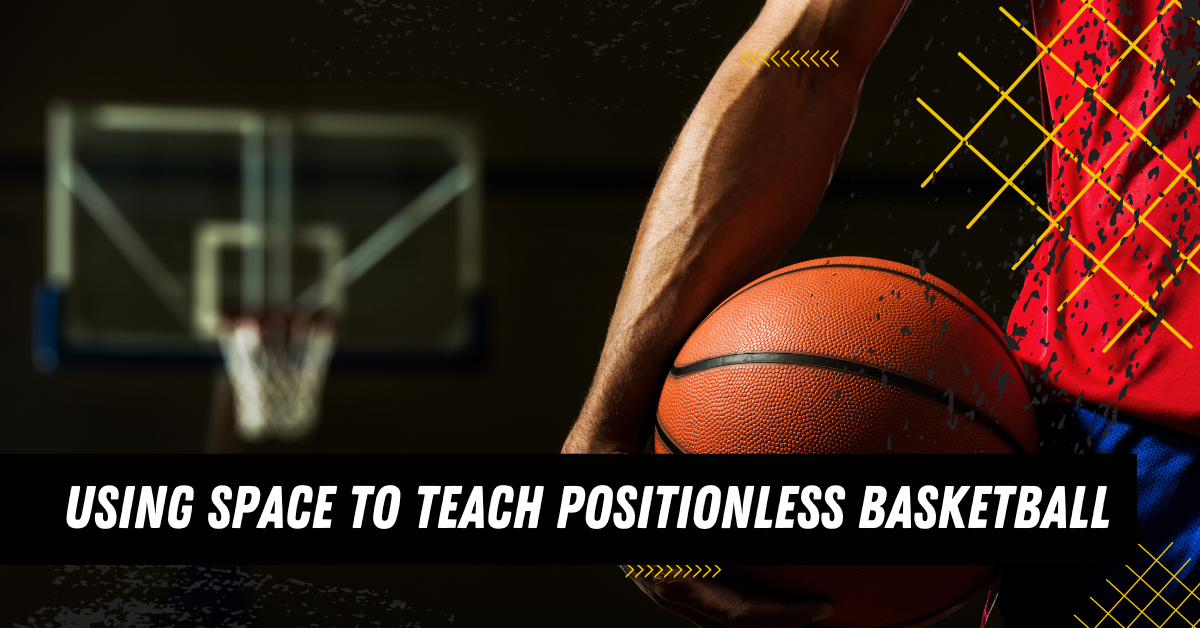Using Space to Teach Positionless BasketballLet's take a moment and flush out some terminology related to the topic of positionless basketball.
What is Positionless Basketball? Positionless Basketball is the term used to describe the style of play that includes all five (5) players on the court not having a particular position. You can go back to old school offensive systems like the Flex Offense, where all of your players are interchangeable, or the Wisconsin Swing, where all players are interchangeable. the CMU Wheel Offense where all players are interchangeable, and the Shuffle Offense, again, where all players are interchangeable. Positionless Basketball is a little bit different in the fact that positionless basketball is focused on teaching all of the players the same skills. For example, guard typically run the offense, handle the ball, attack the paint and distribute to others. The forwards and posts would have much different tasks and play specific positions on the floor. In a Positionless Basketball style, all 5 players would handle the ball, attack the paint, shoot the 3, and set up shop in the paint. Positionless Basketball in the NBA For almost a decade now, we have watched the NBA game transform to an uptempo game with the traditional post players moving to a "Stretch 4" position, where they set the high ball screen and flare to a 3, or dribble hand-off on the perimeter. We have guys like Dirk Nowitzki, Kevin Love, Karl Anthony-Towns, Anthony Davis, and Kristaps Porzingas to name a few. These players, in traditional offensive sets would set up in the post, with their back to the basket and be asked to produce high-percentage shots. However, in today's game, they're stepping out hitting the 3, putting the ball on the ground and attacking the rim. If we use Kevin Durant as an example, he's the epitome of an athlete playing in a positionless style game. In the 90s, Kevin Durant would have been a back to the basket player simply because of his height and length. Don't get me wrong, the back to the basket player still have their place in the game, however, at the highest level, the game is moving away from the traditional back to the basket player. Rick Carlisle, former coach of the Dallas Mavericks regarding the question why 7'3 Kristaps Porzingas isn't in the post using his height. Carlisle states, "The Postups not a good play anymore. it's not a good play for a 7'3 guy. It's a low value situation. Our numbers are substantially better when we space him beyond the 3-point line. When any of our guys go in there, our effectiveness is diminished exponentially. It's counter intuitive, I understand that, but it's a fact. I think there are certain situations when we could get him on a roll into the paint going toward the rim, it's a good situation. We have to realize this game has changed, and we're trying to keep our offense efficient." Positionless Basketball in the NCAA The NCAA also has smaller mid-major teams find great success in moving to the positionless basketball style of play. If we look at NCAA Men's Basketball team statistics, we don't see Duke, Gonzaga, Michigan State or Kansas at the top of any major statistics. They flat out have the best players in the nation that make plays. For teams without athletes that can make plays, there are systems that are really difficult to defend. Some of the teams that see a great deal of success in the NCAA without a dominant post include Fruman, Davidson, South Dakota State, Colgate, VMI and Dayton. All of these teams have moved to an unconventional 5-out style of play. They move their bigger athletes out to the free throw line for high-post dribble-hand off plays, back door cuts to the perimeter players, and attacking the gaps. All of these are happening within constant motion of the players along the perimeter. Gonzaga uses a 5-out ball screen continuity offense, that incorporates a lot of ball screens between their big man and the point guard, as well as dribble hand-off action between the big and the guard. All of this is creating switching situations, and eventually has a 6'1 guard defending a 6'11 player for a flash to the basket or a duck-in action. The offense is designed to create as many mismatches a possible within a shotclock. Postionless Basketball in High School There are a lot of teams that we could write about, but we'll write about a team that we know of in the northern Wisconsin area. The 2003 State Champions, the Ladysmith Lumberjacks ran a 5-out read-and-react offense that was built on constant motion, back cuts, cut and fill action, as well as attacking gaps. Their biggest athlete was 6'2 and score the most points out of this style of play. When he cut through from the top, he filled the corner, his defender was typically a post player and rim protector. While the rim protector set in place to defend the drive or basket cuts, our 6'2 athlete was a very good shooter and would get boatloads of 3s from the corners. This offense was the driving force behind making them extremely hard to defend, as well as highly efficient by grinding down teams until they had a good shot. If you get a chance to get down to the Wisconsin State Championship, you'll see a lot of schools running a 5-out positionless style of play. Neenah, DI state champion and Pewaukee, D2 state champion, both run a 5-out style of play. These schools typically run an open-post style of play to combat the teams with dominant posts that block shots and control the game in the paint. The Benefits of Positionless Basketball There are many pros to the positionless style of play. We'll go through them in a brief list to help you understand why a team should run a positionless style of play, vs a position-based style of play.
The Negatives of Positionless Basketball There are multiple negatives of positionless basketball that do become a detriment to today's game. We'll cover the most important aspects that deem negative to today's game.
How to Implement the Positionless Basketball System There are a couple of really simple ways to implement the positionless basketball system. Pick an Offensive System 1. Read and React: The easiest to teach, and easiest to learn is the Read and React Offense. This is a base 5-out system that has two actions.
The "Read and React" is a simple system to teach, the effectiveness is in how hard the players cut, and the ball handlers ability to deliver a quality pass. You read the defensive players position and make a pass. That's the extend of the offense. There are opportunities to attack gaps, get paint touches, and post up, should a mismatch present itself. 2. Circle Motion Offense: This is another simple 5-out offensive system, built on continuous ball movement and screening. 5-out circle motion focuses on making an entry pass, and an immediate "Butt Cut" or what we call at Rising Stars Basketball a "Circle Cut" where we're simply rubbing the defender by standing in the way, versus setting a firm screen. The opposite guard makes a "Circle Cut" to the rim, and the backside help defender has to make a decision, help on the cutter, or defender the corner filling the top. It's a very difficult offense to defend, opens the paint, and minimizes the amount of dribbles used to keep the offense flowing. Out of 5-Out Circle, we can run stagger screens, DHO (dribble hand off motion), or double flare screens, and even Spurs Motion Strong. Circle Motion has a lot of moving parts (ha ha).
The "Circle Motion Offense" is a great way to ensures all players are interchangeable and can operate at any spot on the floor, can identify cutters, read defenses and attack gaps when pressure gets high. 3. Shuffle Motion Offense: The Shuffle Motion is another empty-post offense that leverages a player in the high-post spot on the floor. Upon entry of the ball from the top to the wing, the player in the high post, sets a screen for a "shuffle cut" which is a high-post back screen for the opposite wing. It's a very difficult offense to defend, simply because teams that play high-pressure defense "on the line, up the line" will get caught in the shuffle cut often. There are multiple moving parts, in this offense.
The Shuffle Motion is much like the Wisconsin Swing, but the screen is set higher, and the floor is spread to open up dribble-drive opportunities or back door cuts. 4. Wisconsin Swing: The Wisconsin Swing Offense is very old offense that most programs in the state of Wisconsin run for its simplicity, and to limit the number of dribbles the players have to make. This is set up in a 4-out, 1-in type of set up. The 1-in, will always set the screen for the swing cut, then receive an immediate down screen from the player up top. The top players align in what is called the "Chute" of lane-line extended. The wings play at the level of the free throw line extended. There are continuous actions that take place, the video will help you see how it is ran.
The offense can continue with UCLA cuts, guard-to-guard ball screens, but the effectiveneness of this offense is predicated on the ability to swing the ball from side to side. Whatever your flavor, if you want more dribbles, or less dribble,s there are multiple options to implement a positionless style of play. Skills Needed to Establish A Positionless System
Conclusion If you're looking to implement a Positionless system, consider these tips and pointers to help you develop your positionless system. It does move your players away from the systematized position-based offense, to a skill-based offense focused on getting players into BETTER positions to score. The drills and skills necessary are also a change, and move away from rehearsing plays each practice to get players into the right position for a layup. The fact remains, layups require a ton of patience against a good team, a good seal on the block is a great shot, but you get very few of them, and the back to the basket score is becoming increasingly difficult. The positionless system allows you to score at the rim, off of a cut, and from the perimeter as the focus is now on skill vs positions. Consider reading the article "Teaching Skill vs Teaching Position" to learn more about the importance of the methodology. |
Rising Stars Basketball |
Areas ServedHayward Wisconsin
Lac Courte Oreilles Winter Wisconsin Bruce Wisconsin Hurley Wisconsin Birchwood Wisconsin Bayfield Wisconsin Ashland Wisconsin |
Rising Stars BasketballWisconsin AAU Basketball
Crossover Crew 3v3 Basketball League Skills Camps Tips & Articles Workouts & Drills Podcast |
Contact Us |
Rising Stars Basketball Club | 10767 Nyman Ave, Hayward Wisconsin | www.Rising-Stars.us | Powered by Superior Marketing

